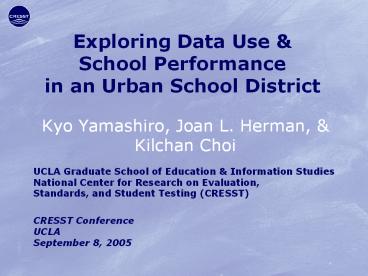Exploring Data Use PowerPoint PPT Presentation
1 / 16
Title: Exploring Data Use
1
Exploring Data Use School Performance in an
Urban School District
- Kyo Yamashiro, Joan L. Herman, Kilchan Choi
UCLA Graduate School of Education Information
StudiesNational Center for Research on
Evaluation,Standards, and Student Testing
(CRESST) CRESST ConferenceUCLASeptember 8, 2005
2
Context Background
- Large urban school district in the Pacific
Northwest - Value-added Assessment System implemented in
District - Need for more info on schools use of data (VA
and other)
3
Data Use Evidence-based Practice
- Data use at the heart of test-based reforms
(NCLB) continuous improvement efforts - Little evidence of effects of data use on
performance - Some evidence shows limited access and capacity
of schools to use data
4
Study Components
- CRESST conducts multi-year, multi-faceted study
of data use - Transformation Plan Review - content analysis of
school improvement plans - Interviews, surveys, and observations from site
visits of case study schools - Analysis of district achievement and survey data
- Observations of school presentations about
progress
5
Sampling
- Latent variable, multilevel analyses used to
estimate gains (student-level, longitudinal ITBS
data in reading math) - Gains based on growth from 3rd to 5th grade for 2
cohorts in each school - 3rd graders in 1998
- 3rd graders in 2001
- Within each cohort, 3 performance subgroups
(average, low, high)
6
Sampling (contd)
- 13 Schools met the following criteria
- Greater than district average of low-SES
students - Starting point below district average
- Beat the Odds Sample (7)
- Higher than average gains
- Relatively more consistent across
- 2 cohorts (98 01)
- reading and math
- performance subgroups (hi, avg, lo)
7
Sample
- Extremely diverse set of 13 small, elementary
schools - African American student populations between 11 -
81 - Asian American student populations between 2 -
59 - White student populations between 5-59
- Enrollment range 134 to 533
8
Transformation Plan Review
- TP Review Rubric (Rating of 1 to 3)
- Types of evidence or indicators used
- Breadth depth VA data technical sophistication
- Identification of goals/objectives or needs
analysis - Identification of solution strategies
- Specificity based on theory/ research/data
- Analysis of progress
- Inclusion of stakeholders
9
Case Study Site Visits
- 2-day visits to 4 case study sites
- Interviews/focus groups
- Principal
- Building Leadership Team (BLT)
- Teachers (primary, upper)
- Teacher Survey
10
Additional Achievement Analyses
- Latent Variable Multiple Cohort (LMC) Design
(with SEMs) - Estimating gains on ITBS based on data across 5
cohorts (1998 to 2002) - Gains for performance subgroups
- Average (students starting at school mean initial
status) - High (students starting at 15 points above
schools average) - Low (students starting at 15 points below
schools average) - Patterns of growth differ from 2-cohort analysis
11
Results Achievement
- Differences between Pre- and Post-Transformation
Plan Reform - High/Avg 4 schools - consistent growth across
rdg math subgroups - Low 6 schools - left some subgroups behind in
math and/or rdg - Very Low 3 schools - no growth or negative gains
12
Results Data Use
- Data Use Is Improving but Still Varied
- Over 3 years, schools increased use of assessment
results and other evidence - Schools increased mention of VA data
- Data Review Process is Inclusive When Capacity
Exists - Principal often conduit (filter, interpret)
- However, many schools developed collaborative
processes for data review - Transf Planning Process May become More
Centralized (Less Inclusive) in Later Years
13
Results Data Use (contd)
- Accessible and Excessive Data
- Teachers use data for schoolwide reform and (to
lesser degree) instructional planning - Teachers are overwhelmed with amount of data
- More Capacity Needed
- Whether schools integrate data into instructional
decisions tended to be person- or climate-driven - Principals need help, too
- More Diagnostic, Instructionally Sensitive Data
Needed - State testing data not seen as useful, valid,
timely, or interpretable - lack of continuity in tests (from grade to grade)
- lack of diagnostic info (item analyses)
- lack of individual growth info (pre-post)
- District assessments seen as more helpful to
instruction
14
Results Data Use Achievement
- Pre-Post Gains Data Use Practices
15
Results Data Use Achievement (contd)
- Ratings overlap for 7 of 13 schools
- For the most discrepant case (Polk)
- showing high gains but low data use
- school in chaos, with new leadership
- For remaining 5 moderate discrepancies, no case
study data
16
Conclusions
- Less use of data for instructional planning
probably a function of - type of data provided
- leadership climate
- capacity
- Principals and teacher leaders need more help in
interpreting and using data - Data use and gains appear to have a moderate link
for struggling schools more case study info
needed - Need for more research on how to use value-added
(gains) in an accountability setting

